The Philippine seas and climate change: Unlocking Blue Carbon Solutions for a cooler planet
It was 2014 when I first set foot in an island community called Nasingin in Bohol province. Nestled just below Banacon island, Nasingin is home to at least 2,400 people. The whole community stretches 1.7km long and I was able to walk around in less than 15 minutes. The ground, made from dirt and coral, disappears twice a day when the high tide comes in.
I visited Nasingin on a research mission to get the locals’ notions on climate change. Constantly battered by fierce typhoons, sea surges, and strong winds, the community knows that nature’s course has changed drastically in the last few years.
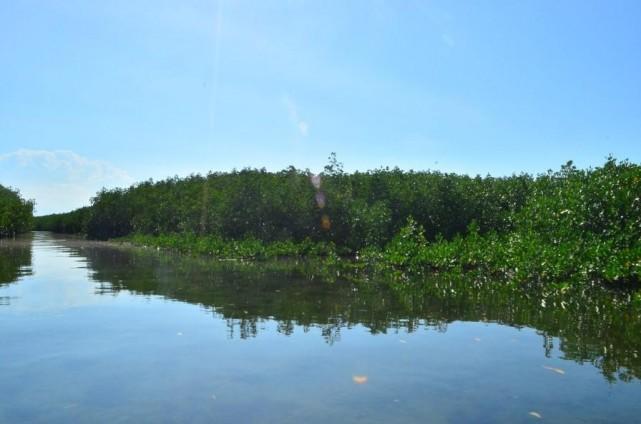
Artemio Vergara, chief of the peoples’ organization, eagerly showed me around. It didn’t take long for me to realize that the community lives in poverty—freshwater supply is scarce, livelihood options are limited to fishing, and household heads usually go to neighboring towns in search for jobs and better opportunities.
But despite these conditions, Nasingin has something that they consider a treasure: the 300-ha mangrove forest cover that frames their island, protecting it from harsh winds and the unfriendly sea.
According to Mr. Vergara, the mangrove forest is a result of collective community action.
“I was twelve years old when we started planting mangroves. Local chieftains here consider this as a priority and as years passed by, we were able to grow this mangrove forest,” he narrated.
Touring the forest cover aboard a motorize banca, the community members proudly show the massive mangrove trees that expands well beyond the island’s horizon. These forests have always been there for them, the community members shared.
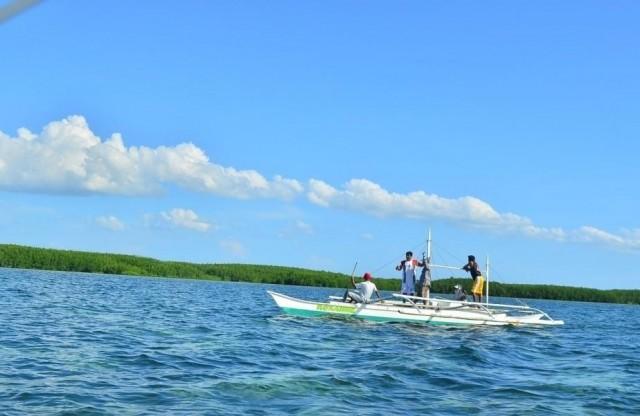
Nasingin often faces destructive typhoons along with sea surges and strong winds. When disaster strikes, nobody could go fishing. Economic activities are disrupted and most families are forced to go hungry. During these trying times, they turn to their mangroves.
“It has always protected us. The mangroves act as a barrier between us and strong waves. That’s why we’re still here. When we couldn’t go out to fish, we usually find shellfish in the mangroves and that’s enough to help us survive,” Maria Luz Sagarino, a community member and a mother of four shared.
The 300-ha mangrove that cradles the community does not only provide valuable protection against the forces of nature, it is also a lifeline for residents of Nasingin. The forest cover served as a breeding ground and nursery for various species of fish, shellfish, and marine animals—most of which can be viable sources of livelihood and sustenance.
And with climate change increasing the likelihood of extreme weather disturbances, Nasingin’s mangrove forest will prove to be a valuable resource not only to the community but to its neighboring towns as well.
Nasingin is just one of the communities in the Philippines that greatly benefits from its mangrove ecosystem. Across the country, these marine reserves present viable blue carbon solutions to mitigate and adapt to the effects of climate change.
The Philippines as a Frontrunner for Blue Carbon Solutions
The Philippines, as an archipelagic country, hosts a significant portion of the world’s mangrove stocks. According to this report by PEMSEA, the East Asian region alone accounts for four million ha of mangroves—roughly 30 percent of the global total. The country has the third largest mangrove ecosystem at 0.26Mha, after Indonesia’s 2.71Mha and Malaysia’s 0.56MHa.
This table estimates that in 2014, the Philippines’ estimated mangrove area amounts to 208, 450 ha.
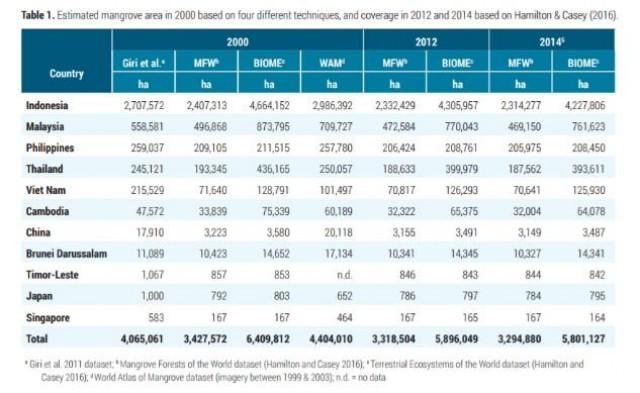
These mangrove cover are extremely important in addressing climate change. In a research conducted by the Nature Conservancy and IHCantabria for the WAVES program of World Bank, it was found out that mangroves helped reduced flooding for 613,000 people annually, 23 percent of whom are living below the poverty line. Mangroves are also responsible for saving as much as US $1 billion in residential and industrial property damages. If mangrove forest cover can be reverted back to their 1950s level, added benefits will be felt by 267,000 people, 61,000 of which are living in extreme poverty condition.
On top of these, mangroves are efficient in sequestering CO2 from the atmosphere. The PEMSEA report underscored that East Asia’s mangrove stocks hold 8.8 billion tons of CO2 and collectively, these mangrove ecosystems sequester 22.4 MMt CO2 from the atmosphere.
In terms of adaptation, mangroves protect coastlines and its communities by absorbing wave energy, providing protection from storm surge, and preventing coastal soil erosion. In some cases, mangroves can also double as seawalls, protecting communities from sea level rise.
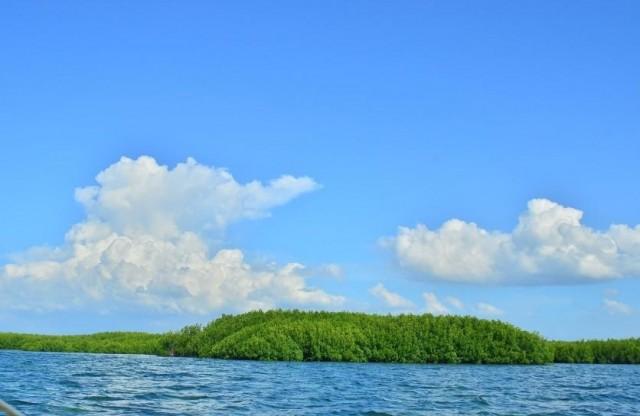
Mangroves are part of coastal blue carbon ecosystems—an umbrella term used to describe mangroves, tidal marshes, and seagrass meadows that can sequester carbon dioxide from the atmosphere and store these for hundreds of years. These ecosystems, aside from sequestering carbon, provide rich breeding grounds for fish stocks, contribute to the filtration of sediment, and ensure the protection of coral reefs from erosion and flooding.
It is essential to unlock blue carbon solutions to help cool down the planet. Experts agree that for humanity to survive, global temperature levels should not increase by more than 2°C. As such, a 1.5-degree increase in global temperature still brings in catastrophic events: more frequent extreme weather disturbances, sea level rise, stronger and longer spells of drought and El Niño, and the extinction of flora and fauna. Mangrove ecosystems, with its proven capacity for carbon sequestration, can be leveraged in a way that strongly supports a country’s achievement of its NDC towards meeting this global goal.
The Philippines, as one of the countries that ratified the Paris Agreement in 2016, has identified the potential of blue carbon solutions in climate change adaptation and mitigation. In fact, the country is one of the five countries that explicitly used this term in its Nationally Intended Contribution (NDC).
In its NDC, the Philippines agreed to “about 70 percent of emission reductions by 2030 relative the business-as-usual (BAU) scenario.” To achieve this, the country highlighted the role that marine ecosystems play, citing blue carbon potentials.
The Threat to Blue Carbon Solutions
Despite their valuable contribution to climate change mitigation, coastal ecosystems around the world are threatened by anthropogenic activities, with over 800,000 hectares destroyed per year. When these ecosystems are destroyed, they release enormous amounts of CO2 in the atmosphere, further contributing to the rise of Earth’s temperature.
According to this policy brief by Nature Conservancy, if half of the annual loss in coastal ecosystems are addressed, it will reduce greenhouse gas emissions by 0.23 GT per year—an amount equivalent to the 2013 emissions of Spain. Further, if wetlands are to be restored to their 1990 cover, potential carbon sequestration can amount to 160Mt CO2 per year—enough to offset 77.4 million tonnes of coal burned. In terms of protecting communities against climate-related disasters, the paper posits that 100 meters of mangroves are enough to reduce wave height by as much as 66 percent.
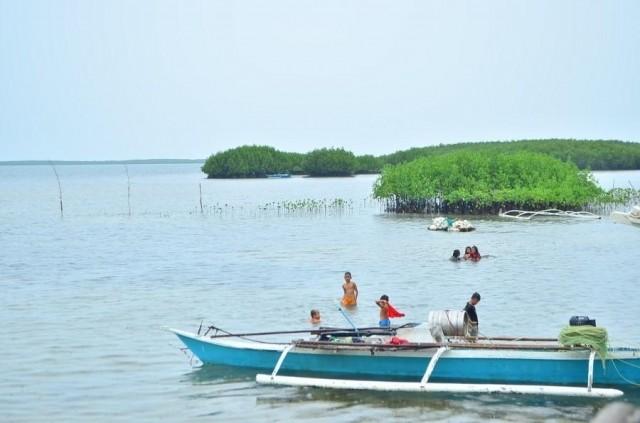
Local Communities, Blue Carbon Solutions towards a Cooler Planet
The 2020 deadline for limiting global temperature increase to 1.5°C is fast approaching and there is a need to act now. The Philippines is strategically endowed with massive assets towards blue carbon solutions.
Measures should be in place to ensure that local communities take the center stage in managing and protecting their resources. In the case of Nasingin, the community is awarded a certificate of stewardship from the Department of Environment and Natural Resources and granting them the authority to plant, manage, and protect their mangrove forest. The agency and the community also entered into a Community-Based Forestry Management (CBFM) contract to ensure that the community will always have the agency and power over their resources.
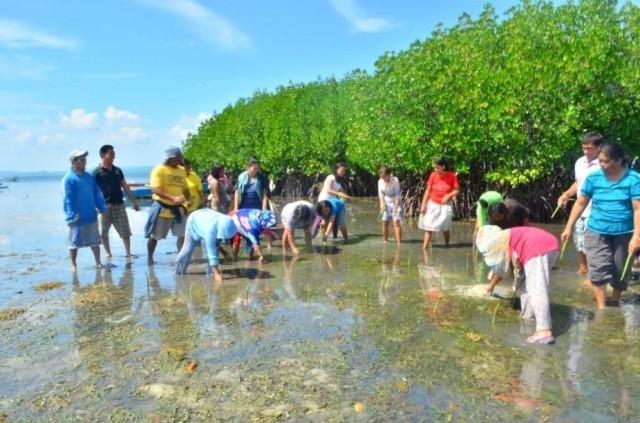
Aside from safeguarding the rights of local communities, it is also imperative to establish an incentive mechanism for those who are heavily dependent on mangrove ecosystems. In Banacon Island, a larger neighboring island of Nasingin, experts estimated that the 40-year mangrove plantation can store as much as 370.7 tons of carbon per hectare. This capacity can pave the way for incentive programs to further stimulate the community’s buy in and provide an economic benefit for their resource management efforts.
Communities should always be in the spotlight in scaling up blue carbon solutions. Technical assistance through capacity building and livelihood programs should be made available to them. As such, the government, together with the academe, should identify and value indigenous approaches to blue carbon solutions and develop these for replication.
Collaboration amongst local government play a key part in scaling up blue carbon solutions as well. A good example for this is the enforcement of the Verde Island Passage Marine Protected Area Network; a 1.14-million hectare marine ecosystem formed by the waters of Romblon, Occidental Mindoro, Oriental Mindoro, and Batangas. The network aims to strengthen enforcement of marine protection laws to ensure the protection of the “center of the center of marine biodiversity.”
Lying in the Pacific Ring of Fire, the Philippines is constantly battered by nature’s forces. Climate change continues to threaten the country’s vulnerability and proves to be a multiplier in the social pressures that it is currently experiencing. However, the Philippines has a lot of solutions under its belt—blue carbon solutions being one of these. Addressing climate change lies on ensuring the wellbeing of our people and making sure that they have the capacity to survive and thrive in these trying times. — LA, GMA News





